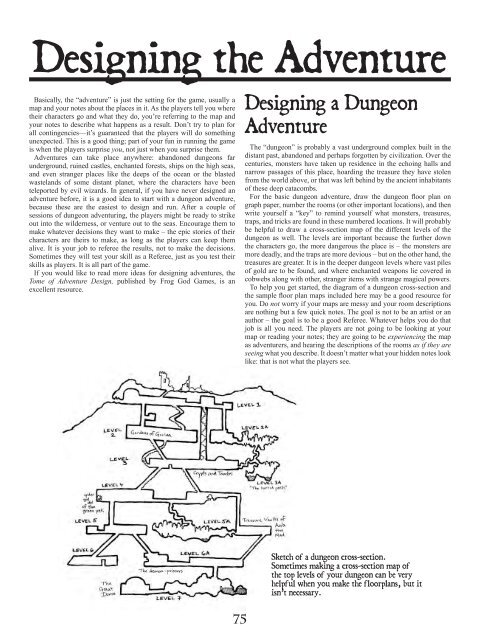Swords-Wizardry-Complete-revised
Swords-Wizardry-Complete-revised
Swords-Wizardry-Complete-revised
You also want an ePaper? Increase the reach of your titles
YUMPU automatically turns print PDFs into web optimized ePapers that Google loves.
Designing the Adventure<br />
Basically, the “adventure” is just the setting for the game, usually a<br />
map and your notes about the places in it. As the players tell you where<br />
their characters go and what they do, you’re referring to the map and<br />
your notes to describe what happens as a result. Don’t try to plan for<br />
all contingencies—it’s guaranteed that the players will do something<br />
unexpected. This is a good thing; part of your fun in running the game<br />
is when the players surprise you, not just when you surprise them.<br />
Adventures can take place anywhere: abandoned dungeons far<br />
underground, ruined castles, enchanted forests, ships on the high seas,<br />
and even stranger places like the deeps of the ocean or the blasted<br />
wastelands of some distant planet, where the characters have been<br />
teleported by evil wizards. In general, if you have never designed an<br />
adventure before, it is a good idea to start with a dungeon adventure,<br />
because these are the easiest to design and run. After a couple of<br />
sessions of dungeon adventuring, the players might be ready to strike<br />
out into the wilderness, or venture out to the seas. Encourage them to<br />
make whatever decisions they want to make – the epic stories of their<br />
characters are theirs to make, as long as the players can keep them<br />
alive. It is your job to referee the results, not to make the decisions.<br />
Sometimes they will test your skill as a Referee, just as you test their<br />
skills as players. It is all part of the game.<br />
If you would like to read more ideas for designing adventures, the<br />
Tome of Adventure Design, published by Frog God Games, is an<br />
excellent resource.<br />
Designing a Dungeon<br />
Adventure<br />
The “dungeon” is probably a vast underground complex built in the<br />
distant past, abandoned and perhaps forgotten by civilization. Over the<br />
centuries, monsters have taken up residence in the echoing halls and<br />
narrow passages of this place, hoarding the treasure they have stolen<br />
from the world above, or that was left behind by the ancient inhabitants<br />
of these deep catacombs.<br />
For the basic dungeon adventure, draw the dungeon floor plan on<br />
graph paper, number the rooms (or other important locations), and then<br />
write yourself a “key” to remind yourself what monsters, treasures,<br />
traps, and tricks are found in these numbered locations. It will probably<br />
be helpful to draw a cross-section map of the different levels of the<br />
dungeon as well. The levels are important because the further down<br />
the characters go, the more dangerous the place is – the monsters are<br />
more deadly, and the traps are more devious – but on the other hand, the<br />
treasures are greater. It is in the deeper dungeon levels where vast piles<br />
of gold are to be found, and where enchanted weapons lie covered in<br />
cobwebs along with other, stranger items with strange magical powers.<br />
To help you get started, the diagram of a dungeon cross-section and<br />
the sample floor plan maps included here may be a good resource for<br />
you. Do not worry if your maps are messy and your room descriptions<br />
are nothing but a few quick notes. The goal is not to be an artist or an<br />
author – the goal is to be a good Referee. Whatever helps you do that<br />
job is all you need. The players are not going to be looking at your<br />
map or reading your notes; they are going to be experiencing the map<br />
as adventurers, and hearing the descriptions of the rooms as if they are<br />
seeing what you describe. It doesn’t matter what your hidden notes look<br />
like: that is not what the players see.<br />
Sketch of a dungeon cross-section.<br />
Sometimes making a cross-section map of<br />
the top levels of your dungeon can be very<br />
helpful when you make the floorplans, but it<br />
isn’t necessary.<br />
75


